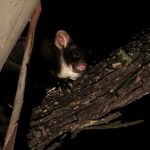GREATER GLIDER
The Greater Glider: Silent Soarer of the Eucalypt Forests
In the tranquil, eucalypt forests of Australia, under the cloak of night, there thrives a remarkable and somewhat elusive creature, the Greater Glider. This nocturnal marsupial, with its large, saucer-like eyes and long, bushy tail, is distinguished by its unique ability to soar through the air, covering distances of up to 100 metres in a single glide. This fascinating ability is facilitated by a membrane stretching from their elbow to their ankle, allowing them to elegantly navigate the forest canopy in search of food and shelter.
A Life Among the Canopies
The Greater Glider primarily dwells in the mature eucalypt forests of eastern Australia, from the northern reaches of Queensland down through New South Wales and into the cooler climates of Victoria. Their habitat is intricately linked to the presence of eucalypt trees, not only for the purpose of gliding but also because their diet consists almost exclusively of eucalyptus leaves. They are highly selective feeders, often favouring the leaves of only a few eucalypt species, which they meticulously chew with their specially adapted teeth.
Sensory Experiences in the Forest
Imagine the scene: as dusk settles and the forest air cools, the scent of eucalyptus oil drifts gently through the canopy. The soft rustle of leaves gives way to the silent, shadowy movement of a Greater Glider as it launches itself from a high branch. Its fur brushes softly against the leaves, barely making a sound, while the cool night air glides effortlessly along its outstretched membrane. The silence is profound, broken only by the distant call of a night bird or the soft crunch of a leaf as the glider lands gracefully on another tree.
The Secret Lives of Greater Gliders
Breeding habits of the Greater Glider are as discreet as their nocturnal wanderings. They are solitary creatures for the most part, coming together only during the breeding season, which peaks in late autumn. A single offspring is born after a gestation period of around 36 days. The young glider then spends the first few months of life nestled in the safety of its mother’s pouch, developing and growing until it is ready to face the world on its own.
- Lifespan: In the wild, Greater Gliders can live for approximately 15 years, though this is influenced by environmental conditions and threats.
- Shelter: By day, they retreat into tree hollows, which provide protection from predators and harsh weather. These hollows are formed in old, mature trees, highlighting the importance of preserving ancient forests.
Threats and Conservation
Sadly, these gentle gliders are facing a multitude of challenges. Their conservation status has been elevated to Vulnerable due to habitat destruction, primarily from logging and land clearing for agriculture. The fragmentation of their habitat not only reduces their living space but also isolates populations, making it difficult for these animals to find mates and maintain genetic diversity. Moreover, climate change poses a significant threat, altering the ecosystems they depend on.
Conservation Actions
- Habitat Protection: Safeguarding mature eucalypt forests and ensuring connectivity between forested areas is paramount. This allows for movement, genetic exchange, and access to food and shelter.
- Research and Monitoring: Ongoing studies into their ecology and behaviour are essential. By understanding their needs, conservationists can develop targeted strategies to mitigate the impact of human activities and climate change.
- Community Engagement: Education and awareness campaigns can inspire local communities and visitors alike to support conservation initiatives and appreciate the role these animals play in their ecosystem.
Why the Greater Glider Matters
The story of the Greater Glider is a poignant reminder of the intricate connections within ecosystems and the far-reaching impact of human actions on wildlife. These gliders are not just fascinating in their own right—they are also indicators of forest health. By fostering a deeper understanding and appreciation for these creatures, we can inspire a commitment to their conservation and the preservation of their habitat.
Let us ensure that future generations will still witness the silent flight of the Greater Glider, weaving through the starlit canopies of Australia’s ancient forests—a symbol of resilience, beauty, and the delicate balance of our natural world.
| Feature | Description |
|---|---|
| Scientific Name | Petauroides volans |
| Habitat | Mature eucalypt forests (QLD, NSW, VIC) |
| Diet | Primarily eucalyptus leaves |
| Lifespan | Up to 15 years in the wild |
| Conservation Status | Vulnerable |
| Unique Adaptation | Gliding membrane from elbow to ankle |
| Key Threats | Habitat loss, fragmentation, climate change |
Learn More
For those interested in contributing to the Greater Glider’s survival, consider supporting organisations working to protect Australia’s forests, joining citizen science projects, or simply sharing the story of this extraordinary marsupial. Every action, big or small, helps weave a future where the forests—and their silent gliders—continue to thrive.

